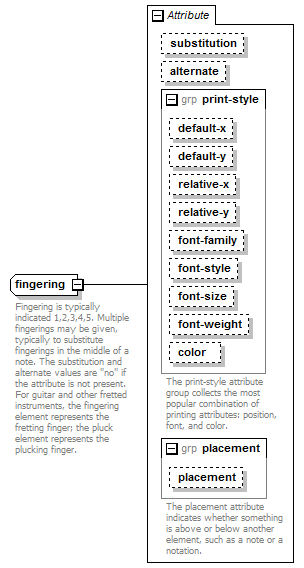fingering
Fingering is typically indicated 1,2,3,4,5. Multiple fingerings may be given, typically to substitute fingerings in the middle of a note. The substitution and alternate values are "no" if the attribute is not present. For guitar and other fretted instruments, the fingering element represents the fretting finger; the pluck element represents the plucking finger. |
Complex Type Information
Model

Attributes
| QName | Type | Fixed | Default | Use | Inheritable | Annotation |
|---|---|---|---|---|---|---|
| alternate | yes-no | optional | ||||
| color | color | optional | ||||
| default-x | tenths | optional | ||||
| default-y | tenths | optional | ||||
| font-family | comma-separated-text | optional | ||||
| font-size | font-size | optional | ||||
| font-style | font-style | optional | ||||
| font-weight | font-weight | optional | ||||
| placement | above-below | optional | ||||
| relative-x | tenths | optional | ||||
| relative-y | tenths | optional | ||||
| substitution | yes-no | optional |
Used By
| Elements | frame-note/fingering, technical/fingering |
Source
<xs:complexType name="fingering"> <xs:annotation> <xs:documentation>Fingering is typically indicated 1,2,3,4,5. Multiple fingerings may be given, typically to substitute fingerings in the middle of a note. The substitution and alternate values are "no" if the attribute is not present. For guitar and other fretted instruments, the fingering element represents the fretting finger; the pluck element represents the plucking finger.</xs:documentation> </xs:annotation> <xs:simpleContent> <xs:extension base="xs:string"> <xs:attribute name="substitution" type="yes-no"/> <xs:attribute name="alternate" type="yes-no"/> <xs:attributeGroup ref="print-style"/> <xs:attributeGroup ref="placement"/> </xs:extension> </xs:simpleContent> </xs:complexType> |